Managing Innovation in Business
VerifiedAdded on 2023/01/12
|9
|2620
|50
AI Summary
This report evaluates the innovation history and existing innovation capabilities and performance of Apple Inc. in the technology industry. It highlights the importance of innovation in business growth and expansion.
Contribute Materials
Your contribution can guide someone’s learning journey. Share your
documents today.
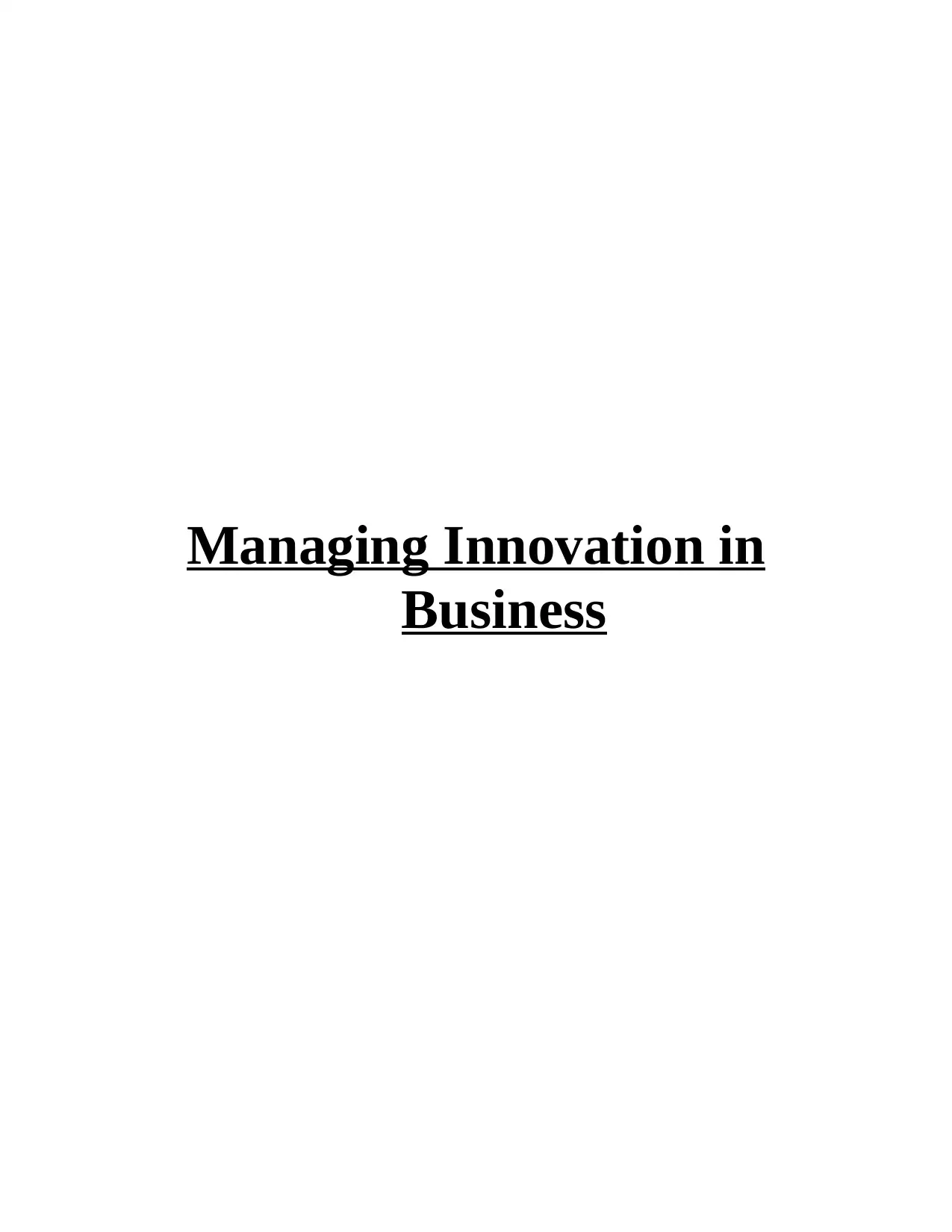
Managing Innovation in
Business
Business
Secure Best Marks with AI Grader
Need help grading? Try our AI Grader for instant feedback on your assignments.
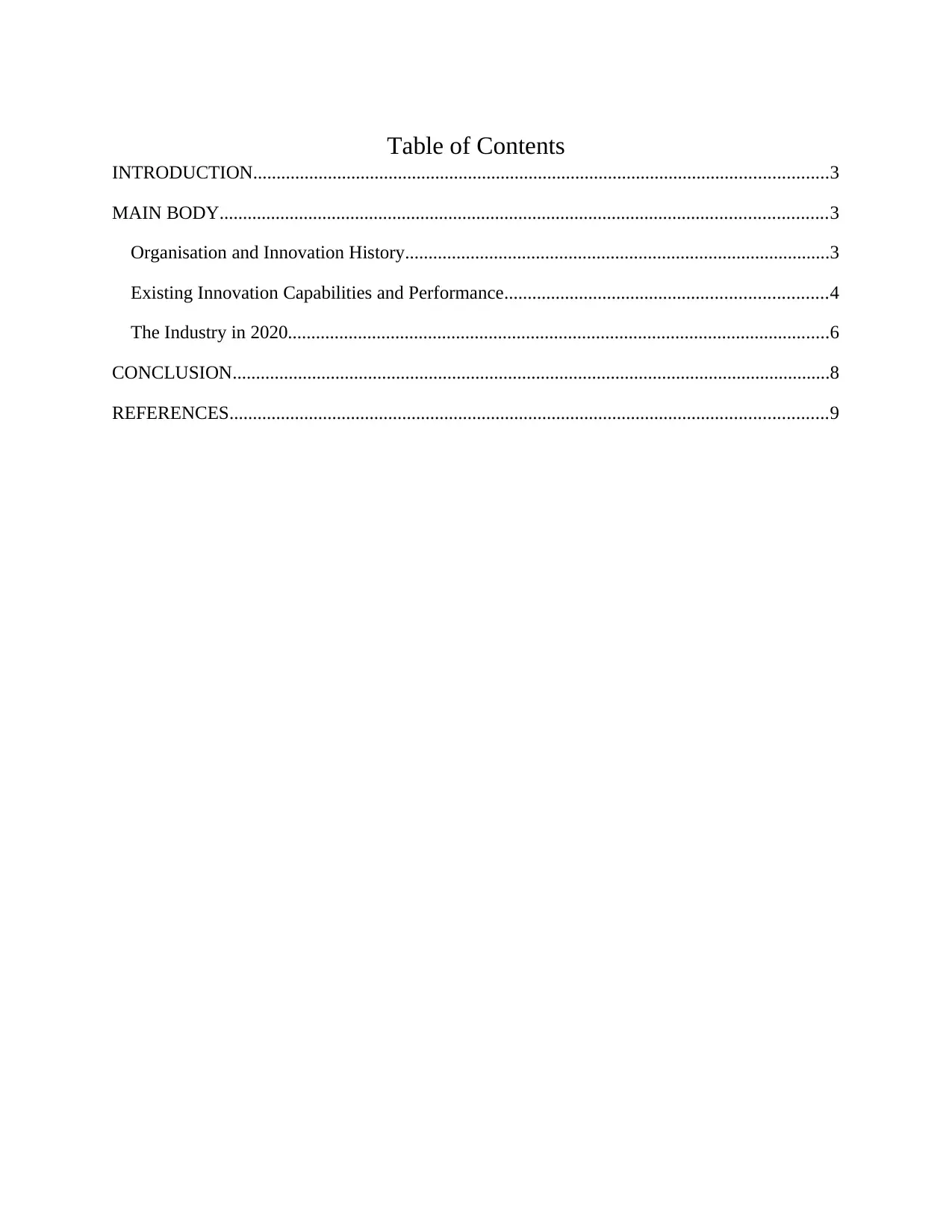
Table of Contents
INTRODUCTION...........................................................................................................................3
MAIN BODY..................................................................................................................................3
Organisation and Innovation History...........................................................................................3
Existing Innovation Capabilities and Performance.....................................................................4
The Industry in 2020....................................................................................................................6
CONCLUSION................................................................................................................................8
REFERENCES................................................................................................................................9
INTRODUCTION...........................................................................................................................3
MAIN BODY..................................................................................................................................3
Organisation and Innovation History...........................................................................................3
Existing Innovation Capabilities and Performance.....................................................................4
The Industry in 2020....................................................................................................................6
CONCLUSION................................................................................................................................8
REFERENCES................................................................................................................................9

INTRODUCTION
Innovation is the strategic process through which additional value is added to existing
products, technology or services available in the market by improving, changing or updating the
way it operates or is applied, in such a way that it increases the performance, efficiency,
productivity and profitability of the product, technology or service in the consumer markets
(Dolata, 2017). The objective of this report is to evaluate the innovation history and existing
innovation capabilities and performance of Apple Inc., a technology business, part of the ‘Big 4
technological companies’ around the world, that operates from its headquarters in California,
USA.
MAIN BODY
Organisation and Innovation History
Apple Inc. was founded in 1976, 44 years ago by Steve Jobs, Steve Wozniak and Ronald
Wayne as ‘Apple Computer Company’. Through their continued operations in the technological
industries, Apple has grown on to become one of the most profitable businesses in the consumer
markets and the world’s most valuable and widely known brand in the 21st century. Currently the
business sells various innovative technologically advanced products that include the IPhone
series of smartphones, IPad series of tablets, Mac series comprising of personal computers, IPod
range of portable media players, Apple Watch range of wearable smartwatches, Apple TV series
of digital media players along with a host of peripheral devices, online services and proprietary
accessories.
Through the continued operations in the technological industries, Apple has had ample
opportunities to grow and expand its business operations and innovation capabilities by
expanding into global markets with the intention to increasing their customer base, market share,
productivity and profitability in the consumer markets. It currently operates more than 500
distinct retail stores around the world that sell Apple products to the consumers exclusively. For
its operations, Apple Inc. employs around 137,000 individuals from around the world. For the
fiscal year of 2018, Apple Inc. was able to generate total annual revenues of $265 billion,
making it one of the world’s most valuable brands and on the basis of their revenues generated
Innovation is the strategic process through which additional value is added to existing
products, technology or services available in the market by improving, changing or updating the
way it operates or is applied, in such a way that it increases the performance, efficiency,
productivity and profitability of the product, technology or service in the consumer markets
(Dolata, 2017). The objective of this report is to evaluate the innovation history and existing
innovation capabilities and performance of Apple Inc., a technology business, part of the ‘Big 4
technological companies’ around the world, that operates from its headquarters in California,
USA.
MAIN BODY
Organisation and Innovation History
Apple Inc. was founded in 1976, 44 years ago by Steve Jobs, Steve Wozniak and Ronald
Wayne as ‘Apple Computer Company’. Through their continued operations in the technological
industries, Apple has grown on to become one of the most profitable businesses in the consumer
markets and the world’s most valuable and widely known brand in the 21st century. Currently the
business sells various innovative technologically advanced products that include the IPhone
series of smartphones, IPad series of tablets, Mac series comprising of personal computers, IPod
range of portable media players, Apple Watch range of wearable smartwatches, Apple TV series
of digital media players along with a host of peripheral devices, online services and proprietary
accessories.
Through the continued operations in the technological industries, Apple has had ample
opportunities to grow and expand its business operations and innovation capabilities by
expanding into global markets with the intention to increasing their customer base, market share,
productivity and profitability in the consumer markets. It currently operates more than 500
distinct retail stores around the world that sell Apple products to the consumers exclusively. For
its operations, Apple Inc. employs around 137,000 individuals from around the world. For the
fiscal year of 2018, Apple Inc. was able to generate total annual revenues of $265 billion,
making it one of the world’s most valuable brands and on the basis of their revenues generated
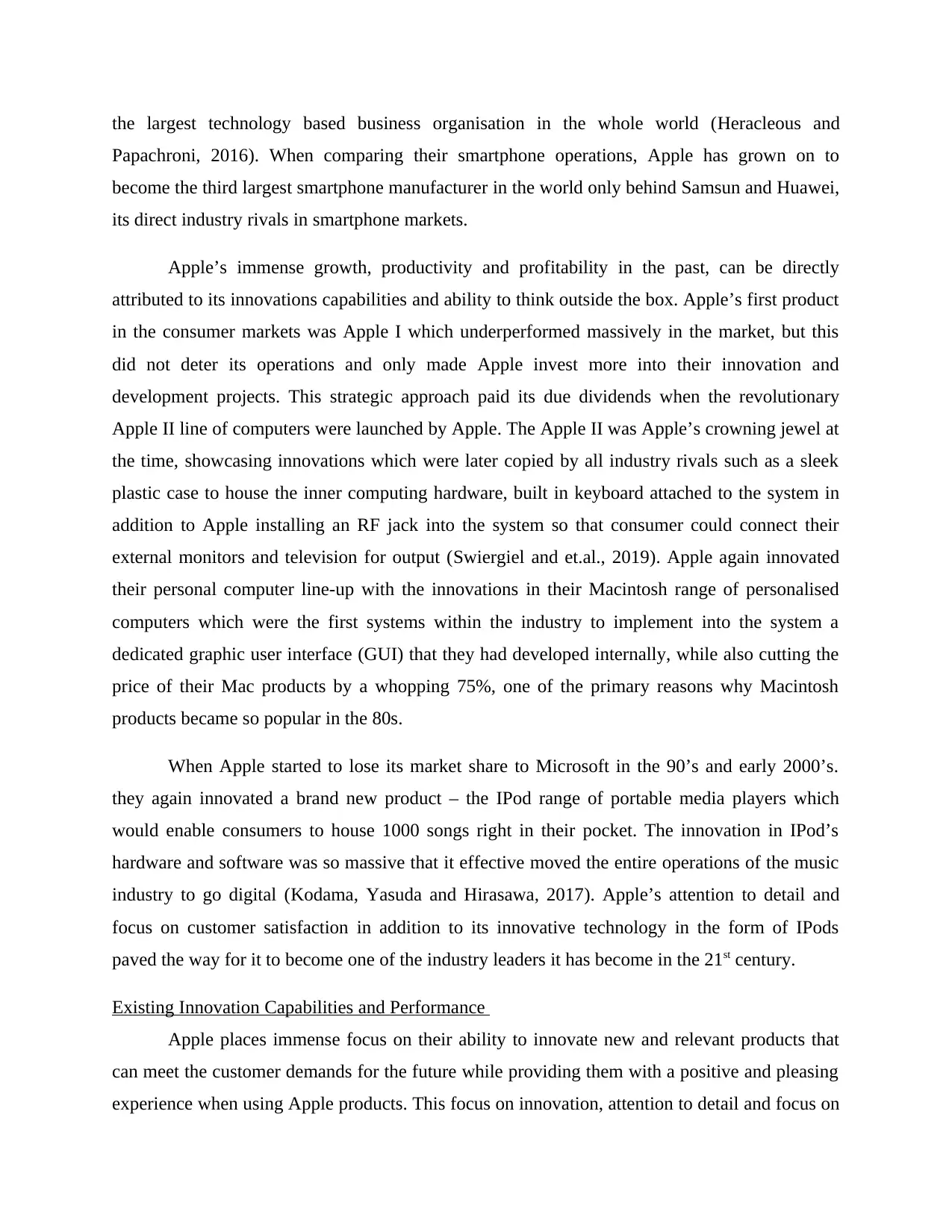
the largest technology based business organisation in the whole world (Heracleous and
Papachroni, 2016). When comparing their smartphone operations, Apple has grown on to
become the third largest smartphone manufacturer in the world only behind Samsun and Huawei,
its direct industry rivals in smartphone markets.
Apple’s immense growth, productivity and profitability in the past, can be directly
attributed to its innovations capabilities and ability to think outside the box. Apple’s first product
in the consumer markets was Apple I which underperformed massively in the market, but this
did not deter its operations and only made Apple invest more into their innovation and
development projects. This strategic approach paid its due dividends when the revolutionary
Apple II line of computers were launched by Apple. The Apple II was Apple’s crowning jewel at
the time, showcasing innovations which were later copied by all industry rivals such as a sleek
plastic case to house the inner computing hardware, built in keyboard attached to the system in
addition to Apple installing an RF jack into the system so that consumer could connect their
external monitors and television for output (Swiergiel and et.al., 2019). Apple again innovated
their personal computer line-up with the innovations in their Macintosh range of personalised
computers which were the first systems within the industry to implement into the system a
dedicated graphic user interface (GUI) that they had developed internally, while also cutting the
price of their Mac products by a whopping 75%, one of the primary reasons why Macintosh
products became so popular in the 80s.
When Apple started to lose its market share to Microsoft in the 90’s and early 2000’s.
they again innovated a brand new product – the IPod range of portable media players which
would enable consumers to house 1000 songs right in their pocket. The innovation in IPod’s
hardware and software was so massive that it effective moved the entire operations of the music
industry to go digital (Kodama, Yasuda and Hirasawa, 2017). Apple’s attention to detail and
focus on customer satisfaction in addition to its innovative technology in the form of IPods
paved the way for it to become one of the industry leaders it has become in the 21st century.
Existing Innovation Capabilities and Performance
Apple places immense focus on their ability to innovate new and relevant products that
can meet the customer demands for the future while providing them with a positive and pleasing
experience when using Apple products. This focus on innovation, attention to detail and focus on
Papachroni, 2016). When comparing their smartphone operations, Apple has grown on to
become the third largest smartphone manufacturer in the world only behind Samsun and Huawei,
its direct industry rivals in smartphone markets.
Apple’s immense growth, productivity and profitability in the past, can be directly
attributed to its innovations capabilities and ability to think outside the box. Apple’s first product
in the consumer markets was Apple I which underperformed massively in the market, but this
did not deter its operations and only made Apple invest more into their innovation and
development projects. This strategic approach paid its due dividends when the revolutionary
Apple II line of computers were launched by Apple. The Apple II was Apple’s crowning jewel at
the time, showcasing innovations which were later copied by all industry rivals such as a sleek
plastic case to house the inner computing hardware, built in keyboard attached to the system in
addition to Apple installing an RF jack into the system so that consumer could connect their
external monitors and television for output (Swiergiel and et.al., 2019). Apple again innovated
their personal computer line-up with the innovations in their Macintosh range of personalised
computers which were the first systems within the industry to implement into the system a
dedicated graphic user interface (GUI) that they had developed internally, while also cutting the
price of their Mac products by a whopping 75%, one of the primary reasons why Macintosh
products became so popular in the 80s.
When Apple started to lose its market share to Microsoft in the 90’s and early 2000’s.
they again innovated a brand new product – the IPod range of portable media players which
would enable consumers to house 1000 songs right in their pocket. The innovation in IPod’s
hardware and software was so massive that it effective moved the entire operations of the music
industry to go digital (Kodama, Yasuda and Hirasawa, 2017). Apple’s attention to detail and
focus on customer satisfaction in addition to its innovative technology in the form of IPods
paved the way for it to become one of the industry leaders it has become in the 21st century.
Existing Innovation Capabilities and Performance
Apple places immense focus on their ability to innovate new and relevant products that
can meet the customer demands for the future while providing them with a positive and pleasing
experience when using Apple products. This focus on innovation, attention to detail and focus on
Secure Best Marks with AI Grader
Need help grading? Try our AI Grader for instant feedback on your assignments.
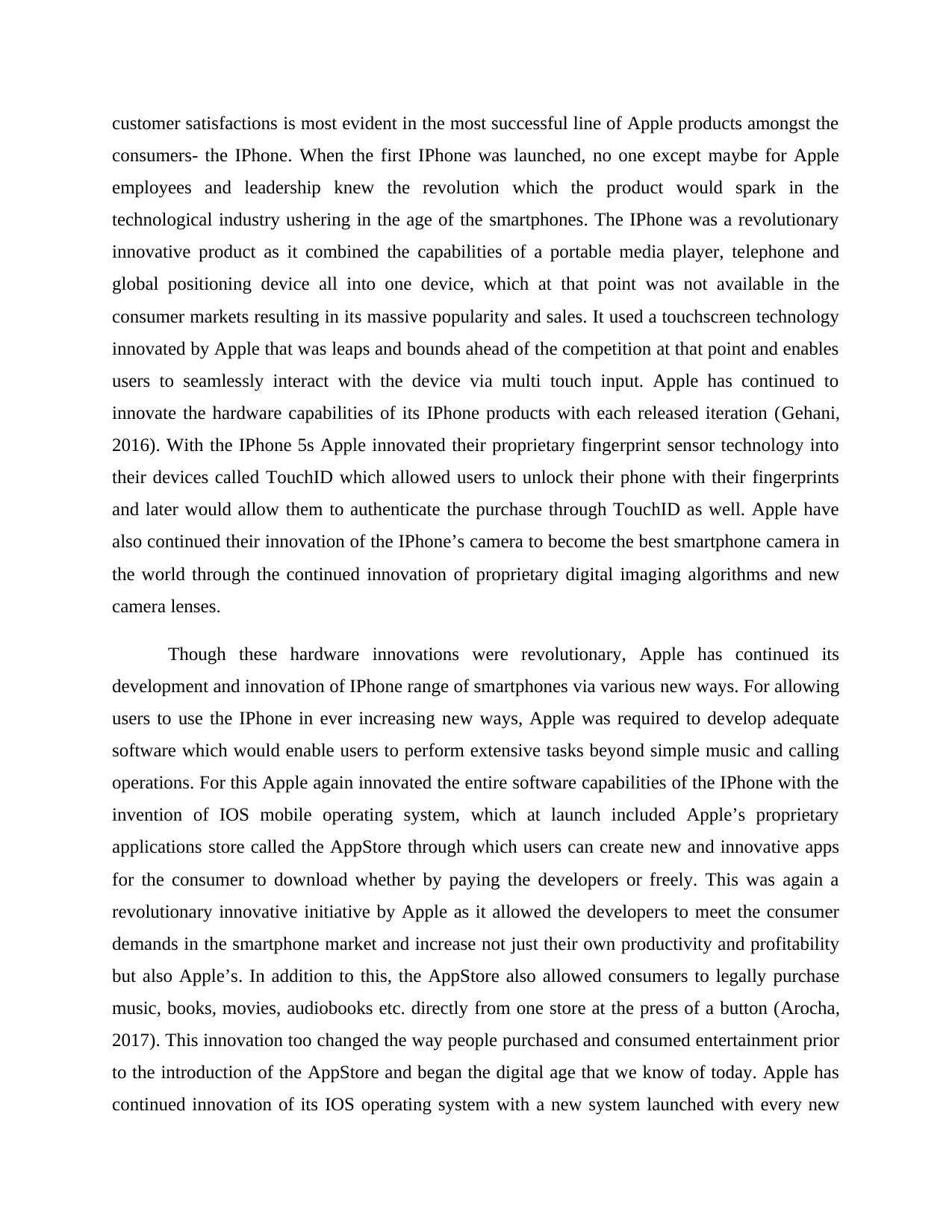
customer satisfactions is most evident in the most successful line of Apple products amongst the
consumers- the IPhone. When the first IPhone was launched, no one except maybe for Apple
employees and leadership knew the revolution which the product would spark in the
technological industry ushering in the age of the smartphones. The IPhone was a revolutionary
innovative product as it combined the capabilities of a portable media player, telephone and
global positioning device all into one device, which at that point was not available in the
consumer markets resulting in its massive popularity and sales. It used a touchscreen technology
innovated by Apple that was leaps and bounds ahead of the competition at that point and enables
users to seamlessly interact with the device via multi touch input. Apple has continued to
innovate the hardware capabilities of its IPhone products with each released iteration (Gehani,
2016). With the IPhone 5s Apple innovated their proprietary fingerprint sensor technology into
their devices called TouchID which allowed users to unlock their phone with their fingerprints
and later would allow them to authenticate the purchase through TouchID as well. Apple have
also continued their innovation of the IPhone’s camera to become the best smartphone camera in
the world through the continued innovation of proprietary digital imaging algorithms and new
camera lenses.
Though these hardware innovations were revolutionary, Apple has continued its
development and innovation of IPhone range of smartphones via various new ways. For allowing
users to use the IPhone in ever increasing new ways, Apple was required to develop adequate
software which would enable users to perform extensive tasks beyond simple music and calling
operations. For this Apple again innovated the entire software capabilities of the IPhone with the
invention of IOS mobile operating system, which at launch included Apple’s proprietary
applications store called the AppStore through which users can create new and innovative apps
for the consumer to download whether by paying the developers or freely. This was again a
revolutionary innovative initiative by Apple as it allowed the developers to meet the consumer
demands in the smartphone market and increase not just their own productivity and profitability
but also Apple’s. In addition to this, the AppStore also allowed consumers to legally purchase
music, books, movies, audiobooks etc. directly from one store at the press of a button (Arocha,
2017). This innovation too changed the way people purchased and consumed entertainment prior
to the introduction of the AppStore and began the digital age that we know of today. Apple has
continued innovation of its IOS operating system with a new system launched with every new
consumers- the IPhone. When the first IPhone was launched, no one except maybe for Apple
employees and leadership knew the revolution which the product would spark in the
technological industry ushering in the age of the smartphones. The IPhone was a revolutionary
innovative product as it combined the capabilities of a portable media player, telephone and
global positioning device all into one device, which at that point was not available in the
consumer markets resulting in its massive popularity and sales. It used a touchscreen technology
innovated by Apple that was leaps and bounds ahead of the competition at that point and enables
users to seamlessly interact with the device via multi touch input. Apple has continued to
innovate the hardware capabilities of its IPhone products with each released iteration (Gehani,
2016). With the IPhone 5s Apple innovated their proprietary fingerprint sensor technology into
their devices called TouchID which allowed users to unlock their phone with their fingerprints
and later would allow them to authenticate the purchase through TouchID as well. Apple have
also continued their innovation of the IPhone’s camera to become the best smartphone camera in
the world through the continued innovation of proprietary digital imaging algorithms and new
camera lenses.
Though these hardware innovations were revolutionary, Apple has continued its
development and innovation of IPhone range of smartphones via various new ways. For allowing
users to use the IPhone in ever increasing new ways, Apple was required to develop adequate
software which would enable users to perform extensive tasks beyond simple music and calling
operations. For this Apple again innovated the entire software capabilities of the IPhone with the
invention of IOS mobile operating system, which at launch included Apple’s proprietary
applications store called the AppStore through which users can create new and innovative apps
for the consumer to download whether by paying the developers or freely. This was again a
revolutionary innovative initiative by Apple as it allowed the developers to meet the consumer
demands in the smartphone market and increase not just their own productivity and profitability
but also Apple’s. In addition to this, the AppStore also allowed consumers to legally purchase
music, books, movies, audiobooks etc. directly from one store at the press of a button (Arocha,
2017). This innovation too changed the way people purchased and consumed entertainment prior
to the introduction of the AppStore and began the digital age that we know of today. Apple has
continued innovation of its IOS operating system with a new system launched with every new
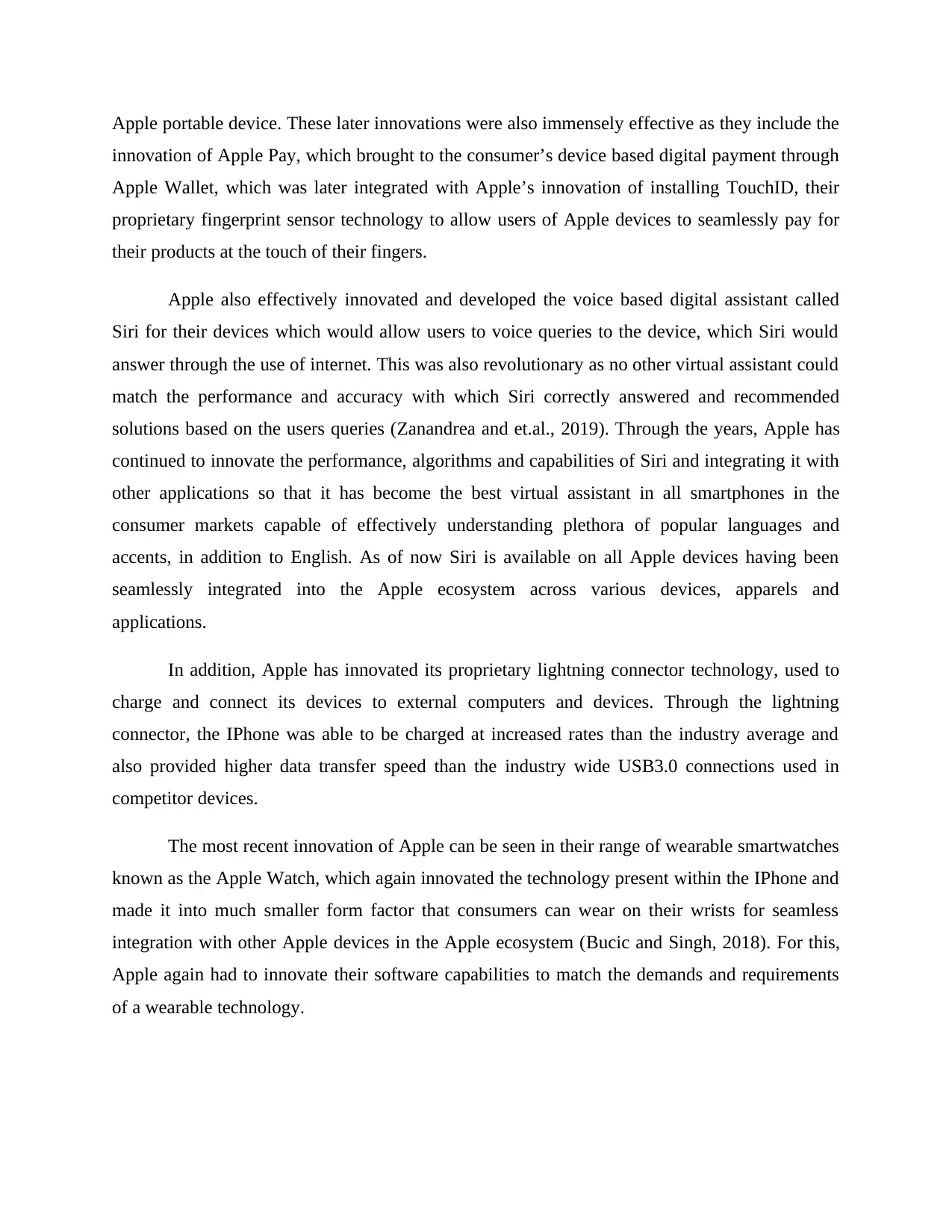
Apple portable device. These later innovations were also immensely effective as they include the
innovation of Apple Pay, which brought to the consumer’s device based digital payment through
Apple Wallet, which was later integrated with Apple’s innovation of installing TouchID, their
proprietary fingerprint sensor technology to allow users of Apple devices to seamlessly pay for
their products at the touch of their fingers.
Apple also effectively innovated and developed the voice based digital assistant called
Siri for their devices which would allow users to voice queries to the device, which Siri would
answer through the use of internet. This was also revolutionary as no other virtual assistant could
match the performance and accuracy with which Siri correctly answered and recommended
solutions based on the users queries (Zanandrea and et.al., 2019). Through the years, Apple has
continued to innovate the performance, algorithms and capabilities of Siri and integrating it with
other applications so that it has become the best virtual assistant in all smartphones in the
consumer markets capable of effectively understanding plethora of popular languages and
accents, in addition to English. As of now Siri is available on all Apple devices having been
seamlessly integrated into the Apple ecosystem across various devices, apparels and
applications.
In addition, Apple has innovated its proprietary lightning connector technology, used to
charge and connect its devices to external computers and devices. Through the lightning
connector, the IPhone was able to be charged at increased rates than the industry average and
also provided higher data transfer speed than the industry wide USB3.0 connections used in
competitor devices.
The most recent innovation of Apple can be seen in their range of wearable smartwatches
known as the Apple Watch, which again innovated the technology present within the IPhone and
made it into much smaller form factor that consumers can wear on their wrists for seamless
integration with other Apple devices in the Apple ecosystem (Bucic and Singh, 2018). For this,
Apple again had to innovate their software capabilities to match the demands and requirements
of a wearable technology.
innovation of Apple Pay, which brought to the consumer’s device based digital payment through
Apple Wallet, which was later integrated with Apple’s innovation of installing TouchID, their
proprietary fingerprint sensor technology to allow users of Apple devices to seamlessly pay for
their products at the touch of their fingers.
Apple also effectively innovated and developed the voice based digital assistant called
Siri for their devices which would allow users to voice queries to the device, which Siri would
answer through the use of internet. This was also revolutionary as no other virtual assistant could
match the performance and accuracy with which Siri correctly answered and recommended
solutions based on the users queries (Zanandrea and et.al., 2019). Through the years, Apple has
continued to innovate the performance, algorithms and capabilities of Siri and integrating it with
other applications so that it has become the best virtual assistant in all smartphones in the
consumer markets capable of effectively understanding plethora of popular languages and
accents, in addition to English. As of now Siri is available on all Apple devices having been
seamlessly integrated into the Apple ecosystem across various devices, apparels and
applications.
In addition, Apple has innovated its proprietary lightning connector technology, used to
charge and connect its devices to external computers and devices. Through the lightning
connector, the IPhone was able to be charged at increased rates than the industry average and
also provided higher data transfer speed than the industry wide USB3.0 connections used in
competitor devices.
The most recent innovation of Apple can be seen in their range of wearable smartwatches
known as the Apple Watch, which again innovated the technology present within the IPhone and
made it into much smaller form factor that consumers can wear on their wrists for seamless
integration with other Apple devices in the Apple ecosystem (Bucic and Singh, 2018). For this,
Apple again had to innovate their software capabilities to match the demands and requirements
of a wearable technology.
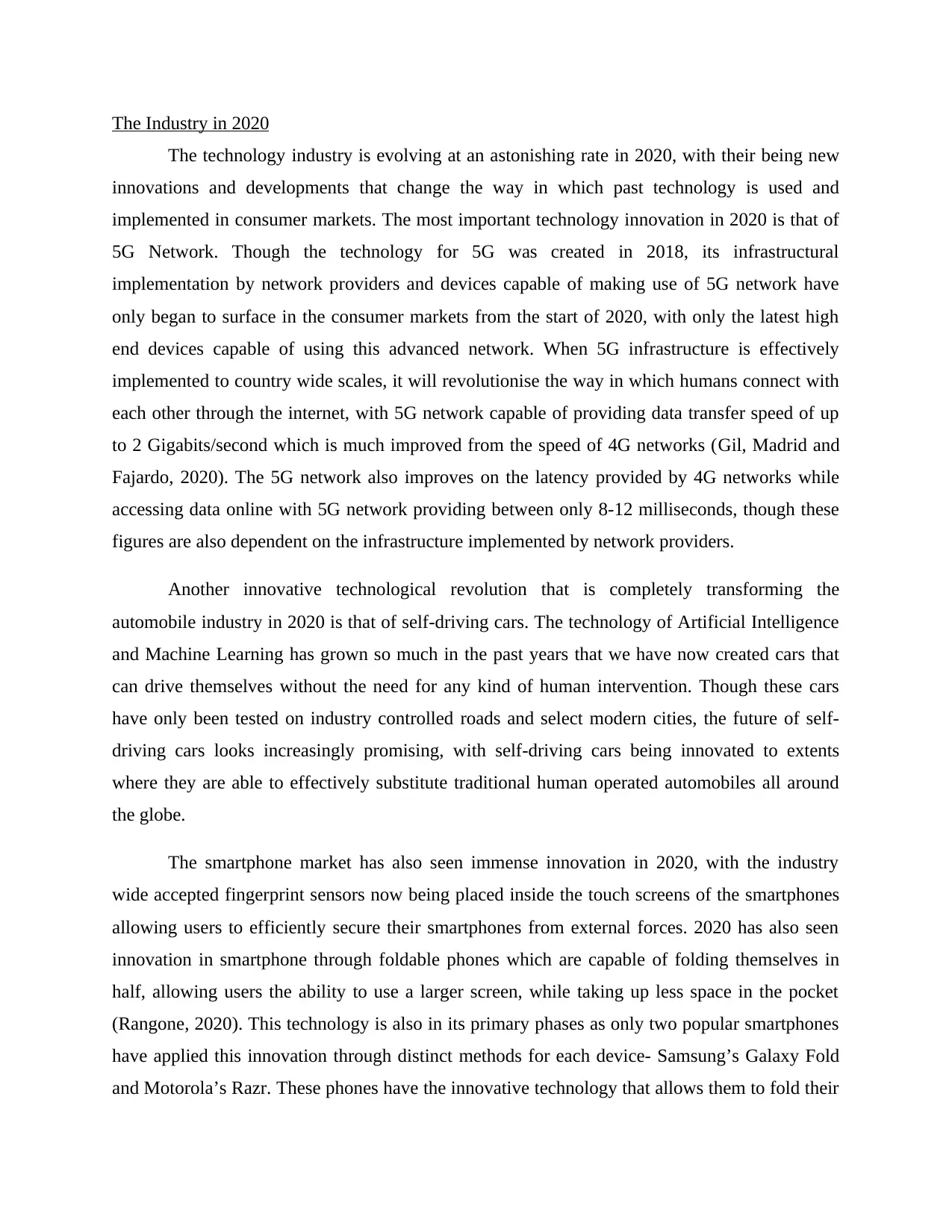
The Industry in 2020
The technology industry is evolving at an astonishing rate in 2020, with their being new
innovations and developments that change the way in which past technology is used and
implemented in consumer markets. The most important technology innovation in 2020 is that of
5G Network. Though the technology for 5G was created in 2018, its infrastructural
implementation by network providers and devices capable of making use of 5G network have
only began to surface in the consumer markets from the start of 2020, with only the latest high
end devices capable of using this advanced network. When 5G infrastructure is effectively
implemented to country wide scales, it will revolutionise the way in which humans connect with
each other through the internet, with 5G network capable of providing data transfer speed of up
to 2 Gigabits/second which is much improved from the speed of 4G networks (Gil, Madrid and
Fajardo, 2020). The 5G network also improves on the latency provided by 4G networks while
accessing data online with 5G network providing between only 8-12 milliseconds, though these
figures are also dependent on the infrastructure implemented by network providers.
Another innovative technological revolution that is completely transforming the
automobile industry in 2020 is that of self-driving cars. The technology of Artificial Intelligence
and Machine Learning has grown so much in the past years that we have now created cars that
can drive themselves without the need for any kind of human intervention. Though these cars
have only been tested on industry controlled roads and select modern cities, the future of self-
driving cars looks increasingly promising, with self-driving cars being innovated to extents
where they are able to effectively substitute traditional human operated automobiles all around
the globe.
The smartphone market has also seen immense innovation in 2020, with the industry
wide accepted fingerprint sensors now being placed inside the touch screens of the smartphones
allowing users to efficiently secure their smartphones from external forces. 2020 has also seen
innovation in smartphone through foldable phones which are capable of folding themselves in
half, allowing users the ability to use a larger screen, while taking up less space in the pocket
(Rangone, 2020). This technology is also in its primary phases as only two popular smartphones
have applied this innovation through distinct methods for each device- Samsung’s Galaxy Fold
and Motorola’s Razr. These phones have the innovative technology that allows them to fold their
The technology industry is evolving at an astonishing rate in 2020, with their being new
innovations and developments that change the way in which past technology is used and
implemented in consumer markets. The most important technology innovation in 2020 is that of
5G Network. Though the technology for 5G was created in 2018, its infrastructural
implementation by network providers and devices capable of making use of 5G network have
only began to surface in the consumer markets from the start of 2020, with only the latest high
end devices capable of using this advanced network. When 5G infrastructure is effectively
implemented to country wide scales, it will revolutionise the way in which humans connect with
each other through the internet, with 5G network capable of providing data transfer speed of up
to 2 Gigabits/second which is much improved from the speed of 4G networks (Gil, Madrid and
Fajardo, 2020). The 5G network also improves on the latency provided by 4G networks while
accessing data online with 5G network providing between only 8-12 milliseconds, though these
figures are also dependent on the infrastructure implemented by network providers.
Another innovative technological revolution that is completely transforming the
automobile industry in 2020 is that of self-driving cars. The technology of Artificial Intelligence
and Machine Learning has grown so much in the past years that we have now created cars that
can drive themselves without the need for any kind of human intervention. Though these cars
have only been tested on industry controlled roads and select modern cities, the future of self-
driving cars looks increasingly promising, with self-driving cars being innovated to extents
where they are able to effectively substitute traditional human operated automobiles all around
the globe.
The smartphone market has also seen immense innovation in 2020, with the industry
wide accepted fingerprint sensors now being placed inside the touch screens of the smartphones
allowing users to efficiently secure their smartphones from external forces. 2020 has also seen
innovation in smartphone through foldable phones which are capable of folding themselves in
half, allowing users the ability to use a larger screen, while taking up less space in the pocket
(Rangone, 2020). This technology is also in its primary phases as only two popular smartphones
have applied this innovation through distinct methods for each device- Samsung’s Galaxy Fold
and Motorola’s Razr. These phones have the innovative technology that allows them to fold their
Paraphrase This Document
Need a fresh take? Get an instant paraphrase of this document with our AI Paraphraser
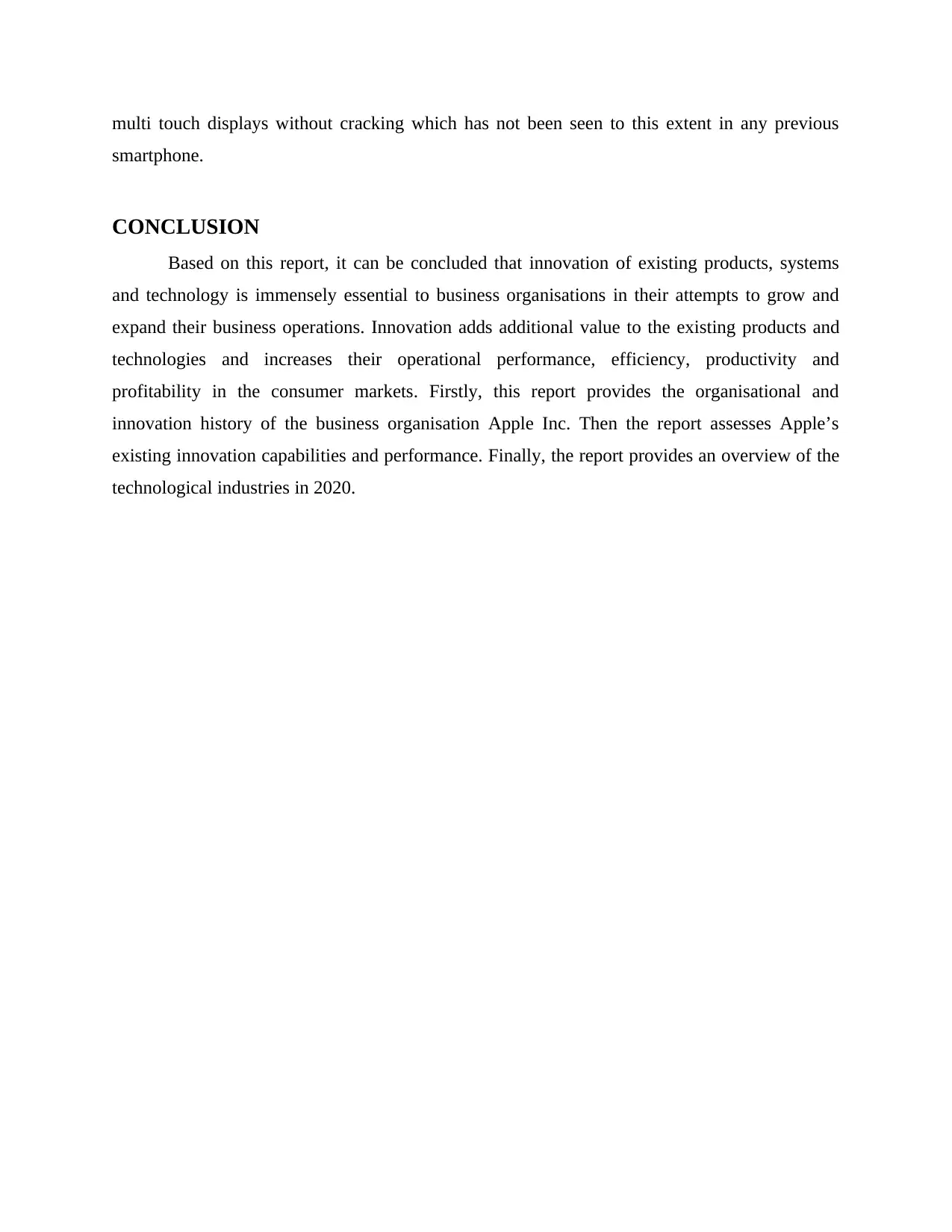
multi touch displays without cracking which has not been seen to this extent in any previous
smartphone.
CONCLUSION
Based on this report, it can be concluded that innovation of existing products, systems
and technology is immensely essential to business organisations in their attempts to grow and
expand their business operations. Innovation adds additional value to the existing products and
technologies and increases their operational performance, efficiency, productivity and
profitability in the consumer markets. Firstly, this report provides the organisational and
innovation history of the business organisation Apple Inc. Then the report assesses Apple’s
existing innovation capabilities and performance. Finally, the report provides an overview of the
technological industries in 2020.
smartphone.
CONCLUSION
Based on this report, it can be concluded that innovation of existing products, systems
and technology is immensely essential to business organisations in their attempts to grow and
expand their business operations. Innovation adds additional value to the existing products and
technologies and increases their operational performance, efficiency, productivity and
profitability in the consumer markets. Firstly, this report provides the organisational and
innovation history of the business organisation Apple Inc. Then the report assesses Apple’s
existing innovation capabilities and performance. Finally, the report provides an overview of the
technological industries in 2020.
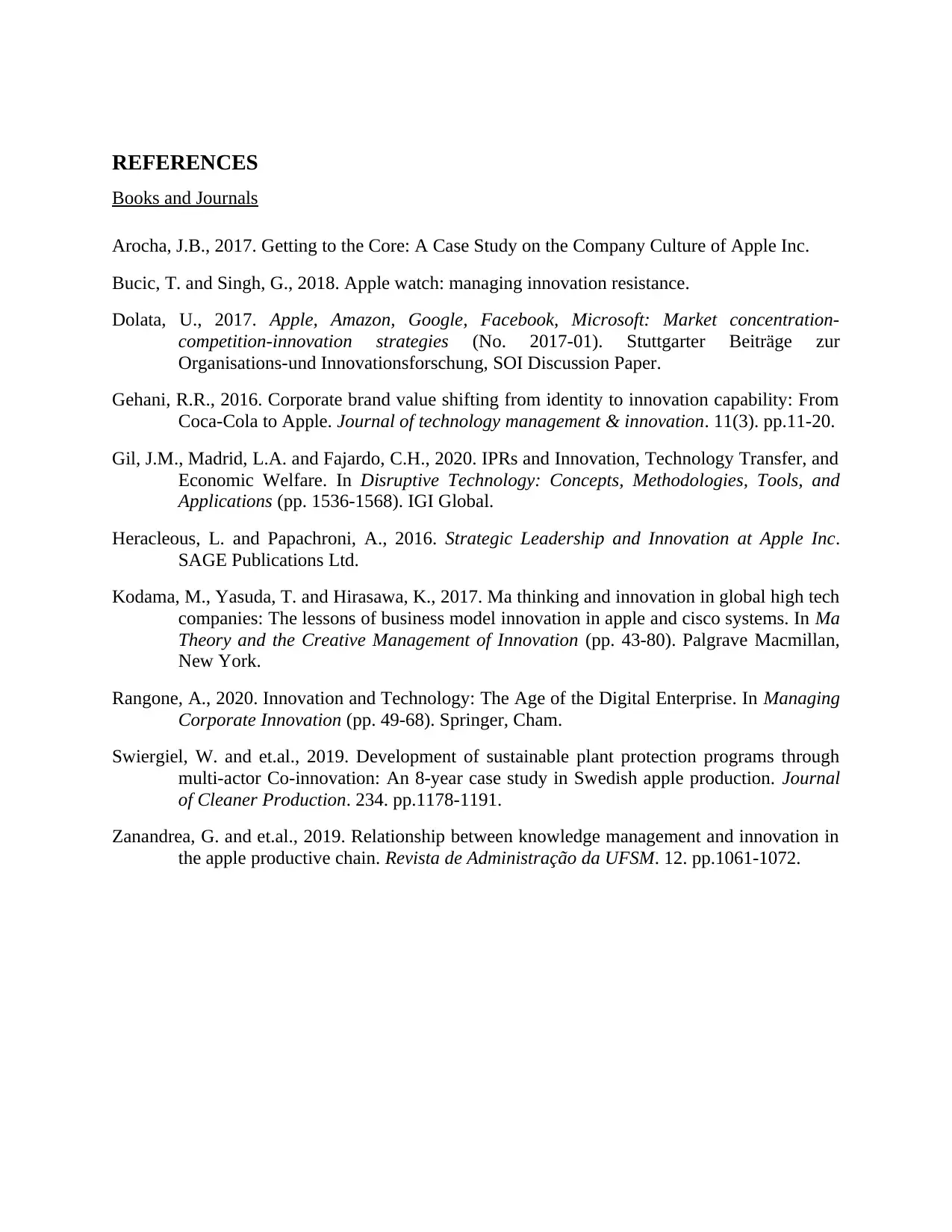
REFERENCES
Books and Journals
Arocha, J.B., 2017. Getting to the Core: A Case Study on the Company Culture of Apple Inc.
Bucic, T. and Singh, G., 2018. Apple watch: managing innovation resistance.
Dolata, U., 2017. Apple, Amazon, Google, Facebook, Microsoft: Market concentration-
competition-innovation strategies (No. 2017-01). Stuttgarter Beiträge zur
Organisations-und Innovationsforschung, SOI Discussion Paper.
Gehani, R.R., 2016. Corporate brand value shifting from identity to innovation capability: From
Coca-Cola to Apple. Journal of technology management & innovation. 11(3). pp.11-20.
Gil, J.M., Madrid, L.A. and Fajardo, C.H., 2020. IPRs and Innovation, Technology Transfer, and
Economic Welfare. In Disruptive Technology: Concepts, Methodologies, Tools, and
Applications (pp. 1536-1568). IGI Global.
Heracleous, L. and Papachroni, A., 2016. Strategic Leadership and Innovation at Apple Inc.
SAGE Publications Ltd.
Kodama, M., Yasuda, T. and Hirasawa, K., 2017. Ma thinking and innovation in global high tech
companies: The lessons of business model innovation in apple and cisco systems. In Ma
Theory and the Creative Management of Innovation (pp. 43-80). Palgrave Macmillan,
New York.
Rangone, A., 2020. Innovation and Technology: The Age of the Digital Enterprise. In Managing
Corporate Innovation (pp. 49-68). Springer, Cham.
Swiergiel, W. and et.al., 2019. Development of sustainable plant protection programs through
multi-actor Co-innovation: An 8-year case study in Swedish apple production. Journal
of Cleaner Production. 234. pp.1178-1191.
Zanandrea, G. and et.al., 2019. Relationship between knowledge management and innovation in
the apple productive chain. Revista de Administração da UFSM. 12. pp.1061-1072.
Books and Journals
Arocha, J.B., 2017. Getting to the Core: A Case Study on the Company Culture of Apple Inc.
Bucic, T. and Singh, G., 2018. Apple watch: managing innovation resistance.
Dolata, U., 2017. Apple, Amazon, Google, Facebook, Microsoft: Market concentration-
competition-innovation strategies (No. 2017-01). Stuttgarter Beiträge zur
Organisations-und Innovationsforschung, SOI Discussion Paper.
Gehani, R.R., 2016. Corporate brand value shifting from identity to innovation capability: From
Coca-Cola to Apple. Journal of technology management & innovation. 11(3). pp.11-20.
Gil, J.M., Madrid, L.A. and Fajardo, C.H., 2020. IPRs and Innovation, Technology Transfer, and
Economic Welfare. In Disruptive Technology: Concepts, Methodologies, Tools, and
Applications (pp. 1536-1568). IGI Global.
Heracleous, L. and Papachroni, A., 2016. Strategic Leadership and Innovation at Apple Inc.
SAGE Publications Ltd.
Kodama, M., Yasuda, T. and Hirasawa, K., 2017. Ma thinking and innovation in global high tech
companies: The lessons of business model innovation in apple and cisco systems. In Ma
Theory and the Creative Management of Innovation (pp. 43-80). Palgrave Macmillan,
New York.
Rangone, A., 2020. Innovation and Technology: The Age of the Digital Enterprise. In Managing
Corporate Innovation (pp. 49-68). Springer, Cham.
Swiergiel, W. and et.al., 2019. Development of sustainable plant protection programs through
multi-actor Co-innovation: An 8-year case study in Swedish apple production. Journal
of Cleaner Production. 234. pp.1178-1191.
Zanandrea, G. and et.al., 2019. Relationship between knowledge management and innovation in
the apple productive chain. Revista de Administração da UFSM. 12. pp.1061-1072.
1 out of 9
Related Documents
Your All-in-One AI-Powered Toolkit for Academic Success.
+13062052269
info@desklib.com
Available 24*7 on WhatsApp / Email
![[object Object]](/_next/static/media/star-bottom.7253800d.svg)
Unlock your academic potential
© 2024 | Zucol Services PVT LTD | All rights reserved.





